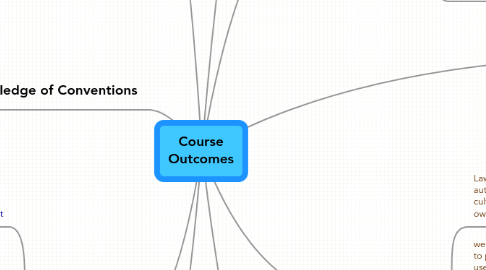Course Outcomes
by Mark McLoone

1. Rhetorical Knowledge
1.1. Identify, articulate, and focus on a defined purpose.
1.2. Respond to the need of the appropriate audience
1.3. Respond appropriately to different rhetorical situations
1.4. Use conventions of format and structure appropriate to the rhetorical situation
1.5. Adopt appropriate voice, tone, and level of formality
1.6. Understand how each genre helps to shape writing and how readers respond to it
1.7. Write in multiple genres
1.8. Understand the role of a variety of technologies/media in accessing, retrieving managing and communicating information
1.9. Use appropriate technologies to organize, present, and communicate information to address a range of audiences, purposes, and genres
2. Knowledge of Conventions
2.1. Learn common formats for different genres
2.2. Develop knowledge of genre conventions ranging from structure and paragraphing to tone and mechanics
2.3. Understand and apply legal and ethical uses of information and technology including copyright and intellectual property
3. C.R.A.P.
3.1. Contrast
3.1.1. control where the readers eyes go
3.1.2. use bold, size, italics and colors
3.2. Repetition
3.2.1. use the same colors, fonts, and images within a page and from page-to-page
3.2.2. use consistent labeling throughout
3.3. Alignment
3.3.1. chose one alignment and stick to it
3.3.2. move elements away from edges
3.4. Proximity
3.4.1. consider the relationship of elements
3.4.2. dont spread elements around to "fill" space; "white" space is okay
4. Creative Commons
4.1. an alternative method for marking creative products and publications.
4.2. becoming increasingly useful for higher education because it will allow faculty to use and share materials without worrying as much about breaking copyright.
4.3. All you need to do is give proper credit to the person who produced/published the image.
5. Critical Thinking, Reading and Writing
5.1. Use information, writing, and reading for inquiry, learning, thinking and communication
5.2. Be able to further express myself through ways of critical thinking, followed by writing
5.3. Integrate previously held beliefs, assumptions, and knowledge with new information and the ideas of others to accomplish a specific purpose within a context
6. Processes
6.1. Be aware that it usually takes multiple drafts to create and complete a successful text
6.2. Develop flexible strategies for generating, revising, editing, and proof-reading
6.3. Understand the collaborative and social aspects of research and writing processes
6.4. To be able to follow standard and creative steps in order to come to a better solution
6.5. Use appropriate technologies to manage data and information collected and gathered
7. Virtual Cultures Notes
7.1. A very good chapter from the book, New Media
7.2. I looked at the "useful websites" portion at the bottom of page 81, and the clickzstats websites has a lot of useful information
7.3. The relationship between technology and presenting ideas has drastically changed in the past few years, and this chapter demonstrates it greatly
8. Copyright
8.1. The Public Domain is the rule, copyright protection is the exception
8.2. Copyright protection should last only as long as necessary to achieve a reasonable compromise between protecting and rewarding the author for his intellectual labour and safeguarding the public interest in the dissemination of culture and knowledge
8.3. What is in the Public Domain must remain in the Public Domain
8.4. The lawful user of a digital copy of a Public Domain work should be free to (re-)use, copy and modify such work.
8.5. Contracts or technical protection measures that restrict access to and re-use of Public Domain works must not be enforced
9. Fair Use
9.1. Law provides copyright protection to “works of authorship” in order to foster the creation of culture. Its best-known feature is protection of owners’ rights
9.2. we as a society give limited property rights to creators to encourage them to produce culture; at the same time, we give other creators the chance to use that same copyrighted material, without permission or payment, in some circumstances. Without the second half of the bargain, we could all lose important new cultural work.
9.3. Fair use is flexible; it is not unreliable
9.4. Fair use is healthy and vigorous in daily broadcast television news, where references to popular films, classic TV programs, archival images, and popular songs are both prevalent and routinely unlicensed.


